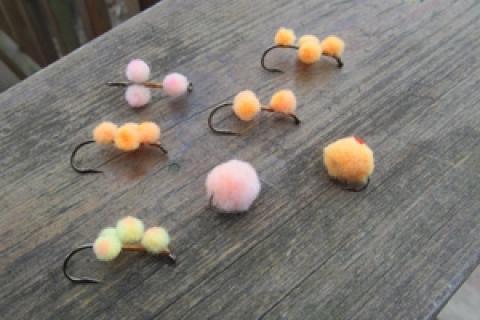
 Crusts of ice formed in the guides of the graphite fly rod and my breath exhaled in whorls of white mist as I cast to the dark forms hovering silently near the bottom of Michigan's Pere Marquette River. Suddenly, almost imperceptibly, the head of one fish turned slightly. Its white mouth opened. Instinctively I tightened on the 6-weight fly line.
Crusts of ice formed in the guides of the graphite fly rod and my breath exhaled in whorls of white mist as I cast to the dark forms hovering silently near the bottom of Michigan's Pere Marquette River. Suddenly, almost imperceptibly, the head of one fish turned slightly. Its white mouth opened. Instinctively I tightened on the 6-weight fly line.
A steelhead, fat from a summer of gorging in Lake Michigan, bucked in response then tore downstream to the next pool. Splashing after it, nearly stumbling, I worked the fish in close to shore, twisted out the barbless hook and watched it dart back into the depths.
Suddenly the cold didn't feel quite so bad.
The fly that fooled that 10-pound steelhead was one of the most unpretentious patterns imaginable — and also one of the most deadly for winter fishing. The fly imitated the eggs of other steelhead, salmon and trout.
The first flies tied to imitate spawn appeared in the 1950s. They were originally dressed fairly large and tried to duplicate a cluster of spawn. Some of these large patterns are still used, but mostly today anglers use single egg imitations in sized 6-12 on short-shank hooks.
When trout, salmon and steelhead spawn, millions of eggs are expelled from their swollen paunches. Only a few actually hatch. In some streams none. What happens to the rest?
For the most part they drift free in the current briefly before being gobbled up by another trout, salmon or steelhead. Fish eggs represent one of the greatest food sources available in fall, winter and early spring. Sometimes they're even eaten by bass, walleyes and various species of panfish. Fish learn quickly that these easy-to-distinguish, bright colored morsels are good to eat, rich in caloric value and abundant. And they're available when few aquatic hatches are coming off and terrestrial insects from land are also scarce.
Some companies make artificial eggs that you can use on a plain hook, such as the Berkley Power Egg. And of course bait fishermen simply use the real thing-single salmon eggs bought in jars or clusters from freshly caught fish.
I've tried all of these, but find flies are the most fun to fish. Egg flies are so simple to construct even a novice can whip out a dozen in an hour or two. You can also buy them from major retail outlets such as Bass Pro Shops and local fly shops.
The two most important decisions when tying or ordering egg flies are size and color. Size is determined by three factors-how : large the fish are, what size natural eggs are most available, and how much angling pressure the fish are subjected to.
Next Week: More details on tying egg flies and tips on fishing them for trout, salmon and steelhead.
- 4194 views

